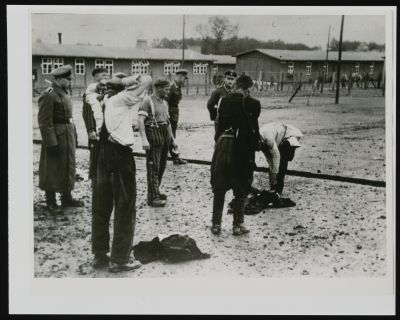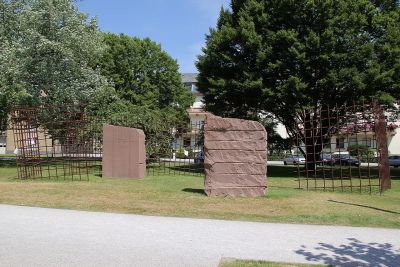The so-called “Germanisation” of Poles in the SS-run Hinzert concentration camp

If an “E-Pole” who was imprisoned by the Gestapo met all the requirements of the “racial screening”, he was handed over to the “Special Department for Re-Germanisable Persons” in the Hinzert SS special camp/concentration camp. During his time in detention, which lasted many months, he then had to undergo a “character examination”, the outcome of which would put the camp leadership in a position to make a conclusive decision about “his ability to be re-Germanised”. At the same time, the family was subjected to a “family screening” relating to alleged racial features. If the family screening came back negative, re-Germanisation failed and the detainee would be deported to a larger concentration camp. If both screenings were positive, “re-Germanisation was deemed to have been concluded and the prisoner was supposed to be released. In practice, the process often deviated from these guidelines, as illustrated by Felix Klormann. The most common deviation consisted of delaying all the individual steps: There was a considerable delay before investigations were started, documents required for a family screening were not requested or provided by the authorities at all at first and then with a considerable delay. Even if results were already available, they were sometimes not actioned, releases were delayed, as were deportations to larger concentration camps; there was sometimes a lack of clarity regarding the jurisdiction. The family screening held more weight that the “character examination”, i.e., greater value was placed on the family to be “Germanised” in the broad sense than on the individual. Sometimes, “E-Poles”, whose assessment in Hinzert had a negative outcome, due to physical infirmity for example, got a second chance if their family screening came back positive. Yet, this examination was difficult to carry out and became more difficult as the war went on because family members might also have been removed to do forced labour, had fled or were no longer in the same place for other reasons, or the original place of residence was no longer within the sphere of influence of the German authorities.[14] A deviation from the intended process also affected Feliks Błaszczyk, who was born near Poznań in 1915. He ended up as a German prisoner of war, and was probably released on 10 March 1941 to be deployed as a forced labourer on a farm in Harxheim in Zellertal (today Rhineland-Palatinate). He was accused of forbidden contact with a German and was taken into “protective custody” on 6 May 1942. The accused woman was arrested on 11 May 1942 and in November 1942 she was sentenced to two years in prison; she stayed in prison until May 1944. Feliks Błaszczyk was not sent to Hinzert until ten months later on 1 March 1943. During the “Germanisation process”, the “racial screening” came back positive. But on 20 September 1943, the result was revised for reasons unknown. Once the positive report had been revoked, he was transported to Natzweiler concentration camp. He was obviously released from there because he married Helena Justynowna, who was born in Raków near Lodz in 1924, in Lebach (Saarlouis district) on 22 September 1945. She had been a forced labourer at the Dillinger Hüttenwerke in Saarbrücken from 1 February 1943 to 1 November 1944. Feliks Błaszczyk died in 1984, Helena Błaszczyk in 2001.[15]
For the “E-Poles”, imprisonment in Hinzert meant many hardships and danger to life and limb. There was nowhere near enough food. Everyday life was marked by work in tyrannical and intentionally very hard conditions and excessive and senseless violence. If anyone became ill, medical assistance was completely inadequate or was not provided at all. Under these conditions, the imprisoned Poles were supposed to prove their manpower as well as their “moral leadership” – by tasks being assigned as functionary prisoners, which were often difficult to do, compulsorily engaged them in the functioning of the camp system and placed then in a moral dilemma.[16]
The number of proven deaths in Hinzert, which has been able to be determined so far, is 321, although various sources suggest that it was actually more and not all mortal remains have been able to be found.[17] It is still not clear just how many Poles were included in this number. In 1946, the French military administration established a memorial cemetery on the land of the former guard camp, in which 217 of the dead who had been buried in the surroundings were reinterred. After decades, in which the memories of the Hinzert SS special camp/concentration camp had faded in the public consciousness, and because of the commitment shown by individuals and small groups who had worked hard since the 1980s, a documentation and meeting centre, which belongs to the Rhineland-Palatinate Regional Centre for Political Education and also houses a permanent exhibition, was finally able to be opened in 2005.[18]
Julia Röttjer, May 2022
[14] Klormann, Felix: “Eindeutschungs-Polen” im SS Sonderlager/Konzentrationslager Hinzert, in: Grotum, Thomas (Publ.), Die Gestapo Trier. Beiträge zur Geschichte einer regionalen Verfolgungsbehörde, Cologne inter alia 2018, p. 115–128, here p. 122– 127.
[15] Hinzert SS Special Camp/Concentration Camp memorial site, permanent exhibition. His biography up to his transportation to Natzweiler concentration camp is presented under the name “Felix Balszezyk”, what happened after that is stated as “unknown”. Further information is based on [Lebach Registry Office], Lists of names of registry office Lebach-Caserne, 9/11-1945–22/12/1945, 10009495/82060762/ ITS Digital Archive, Arolsen Archives. Entries for both people can be found in the database https://straty.pl of the Reconciliation Foundation (Fundacja Pojednanie). In this case, his name is spelt “Feliks Blarszyk” and “Blarsczyk”.
[16] Ibid For the living and working conditions in the camp cf. Bader, Uwe; Welter, Beate: Das SS Sonderlager/KZ Hinzert, in: Benz, Wolfgang; Distel, Barbara (Publ.): Der Ort des Terrors. Geschichte der nationalsozialiatischen Konzentrationslager. Vol. 5: Hinzert, Auschwitz, Neuengamme, Munich 2007, p. 17–74, here p. 30–34.
[17] Ibid, p. 35.
[18] Bader, Uwe; Welter, Beate: Das SS Sonderlager/KZ Hinzert, in: Benz, Wolfgang; Distel, Barbara (Publ.): Der Ort des Terrors. Geschichte der nationalsozialiatischen Konzentrationslager. Vol. 5: Hinzert, Auschwitz, Neuengamme, Munich 2007, p. 17–74, here p. 38f. Organisation’s website: https://www.gedenkstaette-hinzert-rlp.de/ (last accessed on 12/1/2022).


